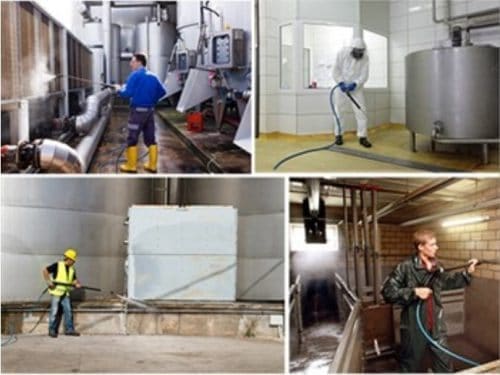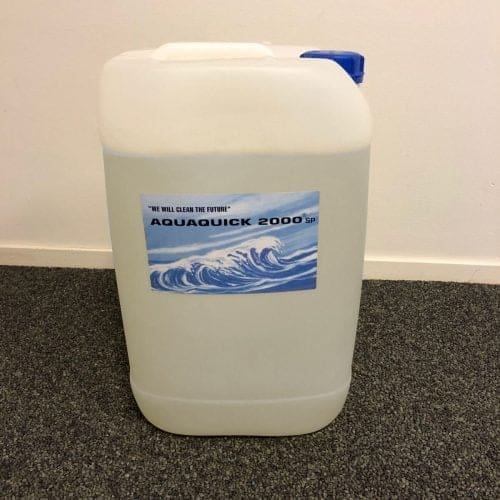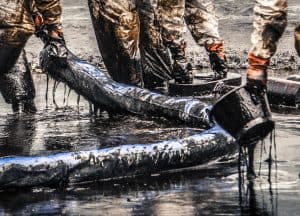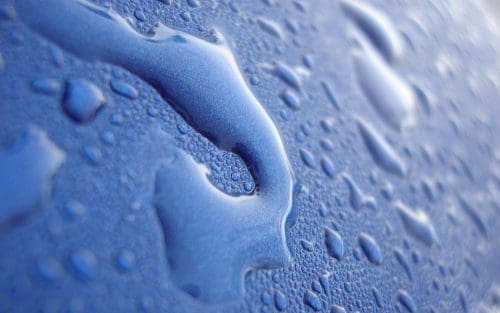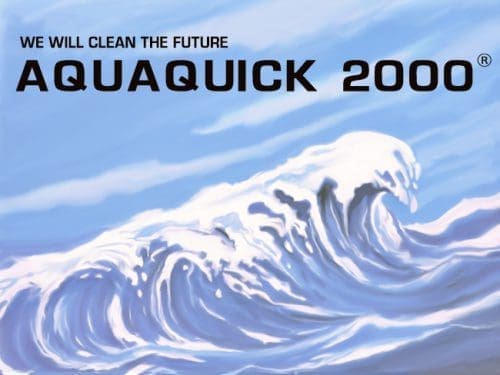In our environmentally conscious era, addressing oil spill cleanup has become a critical task. Whether dealing with a minor cooking oil mishap or a more substantial oil paint, it’s essential to follow a meticulous oil spill cleanup process using the right tools. This comprehensive guide not only provides detailed steps for various oil spill cleanup but also introduces an innovative, environmentally friendly cleaning solution – AQUAQUICK 2000. Learn how to tackle oil spill cleanup effectively while minimizing environmental impact.
Method 1: Cleaning Oil Spill Cleanup
- Pick up glass pieces: Prioritize safety by carefully picking up broken glass with garden gloves or ice cube tongs. Cover the glass in newspaper before disposal to prevent injuries. Wearing shoes with rubber soles is advisable during oil spill cleanup.
- Use absorbent material: Choose from salt, kitty litter, corn starch, sand, or oatmeal as absorbent materials. Cover the entire spill area and let it sit for fifteen minutes to absorb the oil. Blotting up some spill with paper towels before applying absorbent material can be helpful.
- Scoop up the absorbent material: Use paper towels or a spatula to scoop up the absorbent material and oil. Avoid using a vacuum cleaner or mop at this stage, as it may spread the oil spill.
- Wipe up the leftover residue: Employ paper towels or slices of bread to wipe up any remaining oil residue. The floor may feel slightly sticky, but worry not. Mop the floor with a grease-fighting dish detergent and warm water to ensure a clean, residue-free surface.
Method 2: Using Detergent for Oil Spill Cleanup
- Pour dish detergent on the spill: Blot up some oil using paper towels before applying a generous amount of grease-fighting dish detergent directly onto the oil spill.
- Scrub the area: Gently scrub the area with water, using a cleaning brush if the floor hasn’t been stained, or a rag if staining has occurred. Ensure the scrubbing is gentle to avoid damaging the floor.
- Apply more soap and water: Continue scrubbing while applying more soap and water as needed. Use about four tablespoons of water at a time. Scrub until the floor becomes clean and regains its shine.
Method 3: Removing Oil Spills on Concrete
- Sprinkle powder over the spill: For concrete surfaces, use baby powder, talcum powder, or cat litter. Sprinkle it over the spill and use a broom to spread it evenly. Let it sit overnight.
- Sweep up the residue: After letting the powder sit overnight, use a broom to sweep up the residue. Most of the oil should have been absorbed at this point. Paper towels can be used to blot up any remaining residue.
- Wash with detergent: Utilize grease-fighting dish detergent or laundry detergent mixed with hot water to wash the spill area. Let the detergent sit for about an hour if residue persists. Mop or use a cleaning brush to ensure thorough cleaning.
- Rinse with hot water: Rinse off the detergent and remaining oil with warm water. Repeat the process if any oil residue persists.
Method 4: Helping with Environmental Disasters
- Take preventative measures: Advocate for environmentally friendly policies, including those that ban drilling. Support bills aimed at protecting the environment and reducing the likelihood of oil spills.
- Volunteer your help: Search for organizations seeking volunteers for oil spill cleanup. Ensure proper training for specific tasks. Some opportunities, like caring for animals, may require professional qualifications.
- Report injuries and damage: If you are in the vicinity of an oil spill cleanup, promptly call local authorities to report any injuries or damage that may have gone unnoticed. Be aware of hotlines for injured and dead animal sightings.
- Donate to organizations: In certain situations, a monetary donation may be more effective than volunteering. Consider supporting organizations like the National Wildlife Federation and Save Our Seabirds. Companies like Dawn often donate a portion of purchases during oil spill cleanup.
AQUAQUICK 2000 – An Eco-Friendly Oil Spill Cleanup

AQUAQUICK 2000 is a revolutionary water-based biological cleaning product composed of ecological materials and plant extracts for oil spill cleanup. It stands out for its suitability in eliminating all animal, vegetable, synthetic, and mineral oils and greases (hydrocarbons) in a 100% environmentally friendly manner. The product’s unique composition presents no significant health risks, and it is both odorless and colorless which makes it ideal for oil spill cleanup.
AQUAQUICK 2000 SP
AQUAQUICK 2000 SP is an extension of the original product, designed as a fast-splitting surfactant/degreaser proven remarkably good for oil spill cleanup at industrial sites. It is particularly useful in situations where wastewater is drained into the sewage system or the environment while using a grease/oil separator. TUV in Germany has approved AQUAQUICK 2000 SP, confirming its compliance with German regulations and requirements for fast oil spill cleanup, biodegradability, and bioaccumulation.
AQUAQUICK 2000 Benefits
- Multi-functional degreaser: AQUAQUICK 2000 is versatile, suitable for all hydrocarbon combinations. It can effectively eliminate various types of oils and greases without causing damage to metals, plastics, coatings, rubbers.
- Totally ecological and 100% biodegradable: After use, AQUAQUICK 2000 leaves behind only harmless components such as CO2 (carbon dioxide), H2O (water), biomass, and energy. Its ecological footprint is minimal, ensuring a sustainable and environmentally friendly cleaning solution.
- User-friendly, energy & cost-saving, and non-flammable: The product requires no special safety precautions, making it convenient and safe for users. Additionally, it contributes to reduced energy consumption and cost savings.
- Decreases explosion danger of fuels: A notable feature of AQUAQUICK 2000 is its ability to decrease the explosion danger of fuels. This makes it particularly advantageous in situations involving flammable substances.
- Reduction of chemical waste: AQUAQUICK 2000 aids in reducing chemical waste, aligning with the global efforts towards a cleaner and more sustainable environment.
- Accelerated biodegradation of pollution (AQUAQUICK 2000 only): AQUAQUICK 2000 contributes to the accelerated biodegradation of hydrocarbon pollutants. The product’s unique composition stimulates the growth of bacteria and microorganisms present in the environment, converting the AQUAQUICK/hydrocarbon emulsion into harmless components.
The Vast History Of AQUAQUICK
The AQUAQUICK products trace their origins back to the company TKF (Twentsche Krijt Fabriek), founded in 1957. Initially focusing on chalk products like school board chalks and textile marking chalks, the company evolved over the years. The inventor, Mr. Henri de Vries, played a key role in developing AQUAQUICK 2000 in collaboration with the University of Twente.
Since its introduction to the market in 1988, AQUAQUICK 2000 has undergone rigorous testing in numerous independent international research institutes. The product has secured various approvals and certificates, attesting to its safety for both the environment and users. AQUAQUICK 2000 has been a market leader in the Netherlands for the Dutch Fire Brigades since 1998, specifically utilized for oil spill cleanup.
- The Genesis: TKF, Chalk and Oil Spill Cleanup Products

The roots of AQUAQUICK 2000 can be traced back to the establishment of TKF (Twentsche Krijt Fabriek) in 1957. Initially focusing on the production of various chalk products, including school board chalks and textile marking chalks, TKF was a testament to adaptability in meeting the market demands of its time.
Notably, one of TKF’s pioneering inventions was GARBOSOL, a patented textile marking chalk. What set GARBOSOL apart was its revolutionary quality – easy removal with water. This invention marked the company’s foray into products that prioritized user-friendliness and environmental compatibility.
- The Visionary: Henri de Vries
At the helm of this era of innovation was Mr. Henri de Vries, a visionary inventor whose contributions reshaped TKF’s trajectory. De Vries not only played a key role in the development of various chalk products but also pioneered solutions that aligned with the emerging demand for environmentally friendly cleaning options.
The yellow coating on school board chalk, a distinct invention of Henri de Vries, became widely recognized. Another milestone was the creation of GARBOSOL, the patented textile marking chalk known for its easy removal with water, marking a significant step towards sustainable and user-friendly cleaning solutions.
- Collaborative Innovation: AQUAQUICK 2000 Emerges
Responding to the growing need for eco-friendly cleaning products, Henri de Vries embarked on a collaborative journey with the University of Twente. This collaboration laid the foundation for AQUAQUICK 2000, a revolutionary water-based biological cleaning product composed of ecological materials and plant extracts.
The development of AQUAQUICK 2000 in 1988 marked a pivotal moment in the history of cleaning solutions. It was not merely a product but a paradigm shift towards addressing the environmental impact of cleaning practices. The collaboration with a reputable academic institution underscored the commitment to scientific rigor and innovation.
- Continuous Evolution and Testing
Since its introduction to the market, AQUAQUICK 2000 has undergone a journey of continuous evolution and refinement for oil spill cleanup. The product’s formulation, incorporating ecological materials and plant extracts, was designed to not only provide effective cleaning but also to ensure minimal environmental impact.
The commitment to quality and environmental safety led to rigorous testing and examination of AQUAQUICK 2000 in numerous independent international research institutes. These tests served as a validation of the product’s efficacy, safety for users, and adherence to stringent environmental standards and get good oil spill cleanup results.
- Market Leadership: Dutch Fire Brigades and Beyond
The success of AQUAQUICK 2000 was not limited to its environmental attributes; it proved its mettle in practical applications. Since 1998, the product has held a prominent position as the preferred choice for the Dutch Fire Brigades in cleaning road surfaces after oil spills. This adoption by a critical and professional sector was a testament to the product’s reliability in demanding and high-stakes scenarios.
The market leadership attained by AQUAQUICK 2000 within the Netherlands showcased its effectiveness in real-world situations. The Dutch Fire Brigades, known for their rigorous standards, choosing AQUAQUICK 2000 further bolstered its reputation as a trusted and efficient cleaning solution.
Global Recognition: Approvals and Certificates
AQUAQUICK 2000’s journey towards global recognition involved securing approvals and certificates from various regulatory bodies. These accolades were not just symbols of achievement but critical affirmations of the product’s alignment with international standards for safety, biodegradability, and environmental impact.
The widespread acknowledgment of AQUAQUICK 2000’s benefits and its compliance with global regulations positioned it as a leading player in the global market for eco-friendly cleaning solutions. The product’s success story was not confined to a single region but echoed across borders, making it a sought-after choice for environmentally conscious consumers and industries worldwide.
AQUAQUICK 2000 SP: Advancing Environmental Compatibility
Building on the success of AQUAQUICK 2000, the introduction of AQUAQUICK 2000 SP marked another milestone in the product’s evolution. This specialized version, designed as a fast-splitting surfactant/degreaser, showcased a commitment to advancing environmental compatibility in specific scenarios.
The approval of AQUAQUICK 2000 SP by TUV in Germany served as a significant validation. This approval confirmed the product’s compliance with German regulations and requirements for fast-splitting cleansers, biodegradability, and bioaccumulation. AQUAQUICK 2000 SP’s ability to navigate complex environmental situations further solidified its reputation as a reliable and eco-conscious solution. In situations involving flammable substances, AQUAQUICK 2000’s ability to decrease the explosion danger of fuels is a crucial attribute. This feature enhances safety measures, particularly in scenarios where the risk of explosions is a concern.
- Reduction of Chemical Waste
AQUAQUICK 2000’s role in reducing chemical waste aligns with global efforts to minimize the generation of harmful waste. By effectively cleaning oil and grease without the need for excessive chemical agents, the product contributes to a cleaner and safer environment.
- Accelerated Biodegradation of Pollution
One of AQUAQUICK 2000’s distinctive features is its contribution to the accelerated biodegradation of hydrocarbon pollutants. The product’s composition stimulates the growth of bacteria and microorganisms present in the environment, facilitating the conversion of the AQUAQUICK/hydrocarbon emulsion into harmless components.
Final Verdict
As we wrap up this guide, it is clear that addressing oil spill cleanup goes beyond immediate cleanup. Taking preventative measures, volunteering in disaster situations, reporting incidents promptly, and supporting environmental organizations contribute to a collective effort for a cleaner, safer planet. In a world where every action counts, AQUAQUICK 2000 serves as a beacon of hope a product that not only effectively tackles oil spills but does so with an unwavering commitment to ecological sustainability.
As we integrate such oil spill cleanup solutions into our practices, we take a step closer to a future where environmental harmony and effective oil spill cleanup coexist seamlessly. Let this guide be a compass in navigating the path towards a cleaner, greener world.



